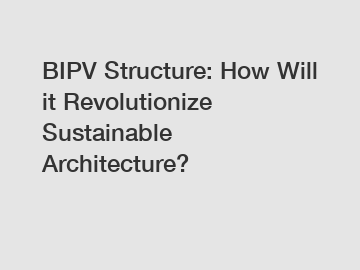BIPV Structure: How Will it Revolutionize Sustainable Architecture?
BIPVBIPV Structure: How Will it Revolutionize Sustainable Architecture?
In recent years, the architectural and construction industry has been striving to find innovative and sustainable solutions to meet the increasing demand for energy-efficient buildings. The concept of Building Integrated Photovoltaic (BIPV) structure has emerged as one such revolutionary approach that not only provides renewable energy but also enhances the architectural aesthetics of buildings. With BIPV, solar panels are seamlessly integrated into the building's design and construction, offering a harmonious blend of functionality and style. The incorporation of BIPV structures is set to revolutionize sustainable architecture in numerous ways.
Improved Energy Efficiency:

One of the primary benefits of BIPV structures is their ability to harness solar energy and convert it into electricity. Traditional solar panels are often placed on rooftops or installed separately from the building, leading to efficiency losses due to transmission and shading issues. However, BIPV integrates photovoltaic elements directly into the building materials, such as windows, roofs, or facades. This integration eliminates transmission losses, maximizing the energy generation potential, and enhancing overall energy efficiency.
Enhanced Aesthetics:
Traditional solar panels can be seen as an eyesore, especially when installed on historic or visually significant buildings. In contrast, BIPV structures offer a seamless integration of solar panels into the architecture, maintaining the building's aesthetics and even enhancing it. These structures come in various designs, colors, and transparency options, allowing architects and designers to create visually appealing buildings that also generate clean energy. BIPV structures blur the line between function and style, making sustainable architecture more attractive to clients and the general public.
Cost-effectiveness:
While the initial installation cost of BIPV structures may be higher compared to conventional construction methods, the long-term benefits outweigh these costs. BIPV structures generate electricity, reducing the need for external energy sources and lowering utility bills. Additionally, they often qualify for government incentives and tax credits, further lowering the overall cost. With advancements in technology, the cost of BIPV materials is expected to decrease, making it a more accessible option for sustainable architecture projects.
Reduced Carbon Footprint:
By utilizing solar energy, BIPV structures reduce the reliance on fossil fuels, effectively reducing carbon emissions. Buildings are responsible for a significant portion of global greenhouse gas emissions, making the integration of renewable energy sources crucial in combating climate change. BIPV structures contribute to creating environmentally friendly buildings that align with the goals of sustainable development.
Adaptability and Versatility:
BIPV structures offer great versatility in terms of their applications. They can be integrated into various building elements, such as glass facades, roof tiles, or curtain walls. This flexibility allows architects to incorporate solar energy generation into both new construction projects and existing buildings. BIPV structures can be retrofitted onto older buildings, increasing their energy efficiency and extending their lifespan. The adaptability of BIPV structures makes them a viable option for a wide range of architectural projects.
Closing Paragraph:
In conclusion, the integration of BIPV structures is set to revolutionize sustainable architecture by offering improved energy efficiency, enhanced aesthetics, cost-effectiveness, reduced carbon footprint, and adaptability. By seamlessly incorporating solar panels into the building's design, architects can create energy-efficient buildings that also meet the aesthetic requirements of clients and the public. As the demand for sustainable architecture continues to grow, BIPV structures provide an innovative and practical solution. To explore how BIPV structures can transform your architectural projects, contact us and join the sustainable building revolution today.
Contact us to discuss your requirements of what is bipv, bipv product. Our experienced sales team can help you identify the options that best suit your needs.
176
0
0

Comments
All Comments (0)